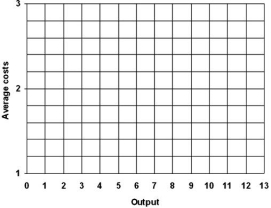The table below contains short run average cost data for five different plant sizes for C3PO Technologies Ltd.

a)On the grid in the figure below,graph the short-run average cost curves for the five plants. 
b)What is the right-size of plant for each of the following output levels:2,4,6,8 and 10?
c)Do a sketch of the long-run average cost curve in the graph above.
d)What plant size would C3PO need to use in order to achieve MES?
e)If C3PO is producing an output level of 6 in plant size 4,does excess capacity exist?
Definitions:
Mergers
The combination of two or more companies into a single entity, typically to increase market share or reduce competition.
Standard Oil Case
A 1911 antitrust case in which Standard Oil was found guilty of violating the Sherman Act by illegally monopolizing the petroleum industry. As a remedy, the company was divided into several competing firms.
U.S. Steel Case
The antitrust action brought by the federal government against the U.S. Steel Corporation in which the courts ruled (in 1920) that only unreasonable restraints of trade were illegal and that size and the possession of monopoly power were not by themselves violations of the antitrust laws.
Cellophane Case
The Cellophane Case refers to a landmark antitrust case involving DuPont's monopoly on the cellophane market, highlighting issues of market definition and competition.
Q12: Adam Smith observed that the division of
Q18: Refer to the graph above to answer
Q24: Refer to the graph above to answer
Q39: Refer to the graph above to answer
Q41: Refer to Table 5.14 to answer this
Q79: Refer to Table 10.5 to answer this
Q82: Implicit costs are the amounts actually paid
Q105: What will happen to total product after
Q112: What is meant by the term utility?<br>A)A
Q186: What is true about the price elasticity